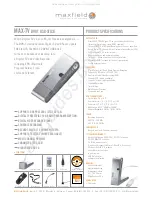
MFJ-945E Mobile Tuner
1
MFJ-945E MOBILE TUNER
General Information:
The
MFJ-945E Mobile Tuner
is a compact tuner designed for mobile operation in cars, trucks,
RV's, and boats. Covering
1.8
to
30 MHz
, it will match virtually any transmitter to almost any
mobile whip antenna. It will also match almost any antenna for home station operation such as
dipoles, inverted-vees, verticals, beams, random wires, and others fed by coax lines or single wire.
The
MFJ-945E
employs a cross-needle meter so forward power, reflected power, and SWR may
be read simultaneously. The meter lamp can be powered by a 12Vdc, 300mA source, such as the
MFJ-1312B
for home-station operation. The meter lamp
ON/OFF
switch will activate the meter
lamp. Use a 2.1mm coaxial plug with the center conductor of the plug connected to the positive
and the sleeve connected to ground. Optional mobile mounting bracket (
MFJ-20
) is available.
Cross-Needle SWR/Wattmeter:
The
MFJ-945E
utilizes a cross-needle meter to read
FORWARD
power,
REFLECTED
power and
SWR
simultaneously in either
HI
(300 Watts) or
LO
(30 Watts) power ranges. Set the power
range switch to
HI
or
LO
. Next read the
FORWARD
power on the
Forward Scale
.
REFLECTED
power is shown at the same time on the
Reflected Scale
.
SWR
is read by observing where the two
needles cross. No
SWR
sensitivity adjustment needed to read
SWR
. The
HI
range is
300
Watts
FORWARD
and
60
Watts
REFLECTED
. The
LO
range is
30
Watts
FORWARD
and
6
Watts
REFLECTED
. The
MFJ-945E
is factory calibrated on the
LO
scale at
10
Watts
FORWARD
and
2
Watts
REFLECTED
, and on the
HI
scale at
100
Watts
FORWARD
and
20
Watts
REFLECTED
.
Installation:
1.
Place the tuner in a convenient location at the operating position. Avoid placing the tuner
near microphones, speech processors, TNC's or other RF sensitive devices.
2.
Install the
MFJ-945E
between your transmitter and antenna. Connect a coax line from your
transmitter to the SO-239 connector labeled
TRANSMITTER
on the rear panel of the tuner.
Connect your antenna to the SO-239 connector labeled
ANTENNA
on the rear panel of the
tuner. A random wire antenna may be connected to the center connection of the
ANTENNA
connector. The random length wire should be long, high, and as clear of surrounding
objects as possible! For optimum operation, the wire antenna should be a
1/4-wavelength
or longer at the operating frequency. Do
not
ground the random wire antenna. Ensure that
the tuner is well grounded to the transmitter! A post labeled
GROUND
is provided for
ground connection(s).
NOTE:
If random wire operation is desired, position the tuner so that the rear panel terminals
can not be contacted by persons or conductors! When transmitting with random wire,
the rear panel connectors can operate with high RF voltages. These voltages may
cause serious burns and may also damage anything contacting or within 1/2" of the
terminals!
Содержание MFJ-945E
Страница 5: ......























